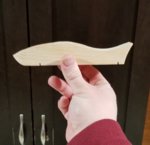Hi all,
I'm a new member and this is my first post. My son has his Pinewood Derby in a week and we're getting ready to add weight to his car. I know the primary place to add weight is in the rear, specifically 3/4" - 1" in front of the rear axle but would it make any sense to also put a little weight near the front axle too for added stability as well as a boost out of the gate? My sons pack is a strict by the book, stock only race (i.e. - no railriding, no bent axles, no riding on 3 wheels etc.), his cars design is a shark (he's 8, very into sharks right now...lol) so it already has more weight towards the front with the body than the rear with the tail by design so maybe he doesn't even need to worry about the front and just put all his weight towards the rear. We also did put the axle hole closest to the end of the block in the rear and the on furthest from the end in the front. Any help would be appreciated!
I'm a new member and this is my first post. My son has his Pinewood Derby in a week and we're getting ready to add weight to his car. I know the primary place to add weight is in the rear, specifically 3/4" - 1" in front of the rear axle but would it make any sense to also put a little weight near the front axle too for added stability as well as a boost out of the gate? My sons pack is a strict by the book, stock only race (i.e. - no railriding, no bent axles, no riding on 3 wheels etc.), his cars design is a shark (he's 8, very into sharks right now...lol) so it already has more weight towards the front with the body than the rear with the tail by design so maybe he doesn't even need to worry about the front and just put all his weight towards the rear. We also did put the axle hole closest to the end of the block in the rear and the on furthest from the end in the front. Any help would be appreciated!

